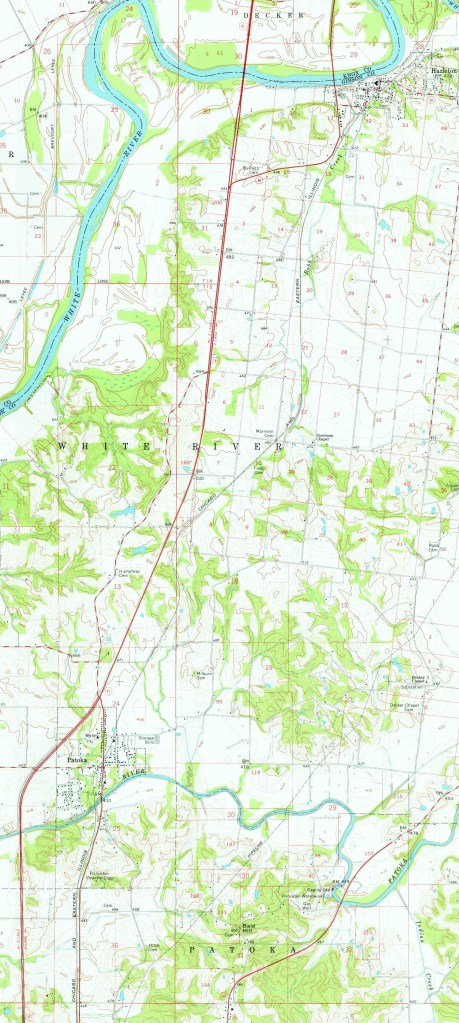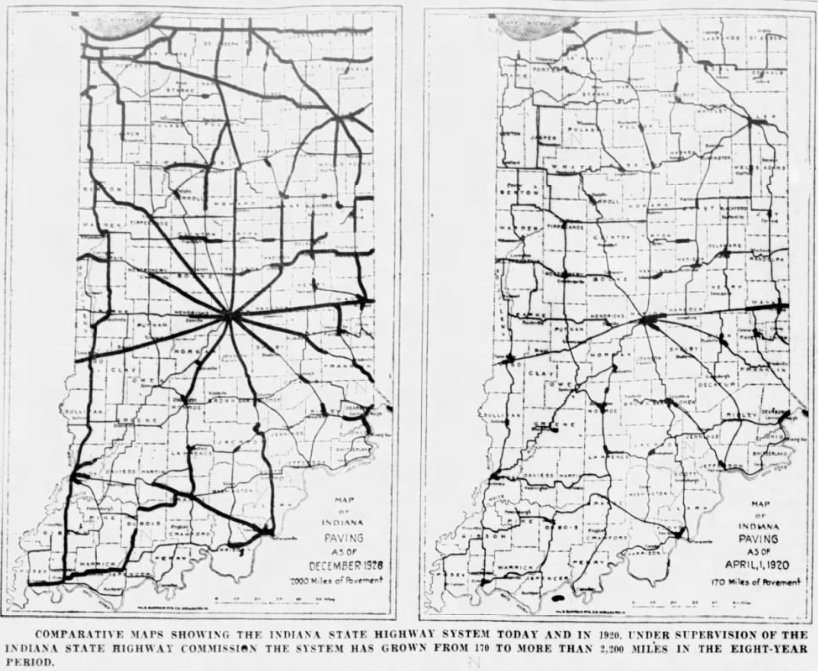Today, we look at the third county in alphabetical order in the State of Indiana. Bartholomew County would have very few changes in its state highway history. It was located on the Jackson Highway south of Indianapolis, along what would become State Road 1. That very same road branched at Columbus, with one branch continuing south to Jeffersonville and the other running to Madison. It was the latter branch that gave the name to the same road in southern Marion and northern Johnson counties.
January 8, 1821: Formation by statute effective February 12, 1821. The formation affected Jackson County and Delaware. The county was organized by act January 9, 1821, effective February 12, 1821.
Boundaries: “Beginning at the south west corner of section eighteen in township seven north of range four east, thence north to the northwest corner of township ten north of range four east, thence east with the line dividing townships ten and eleven north to the north east corner of township ten of range seven east, thence south with the range line dividing ranges seven and eight to the south east corner of section thirteen, in township eight north of range seven east, thence west to the range line dividing ranges six and seven at the north west corner of section nineteen in township eight north of range seven east, thence south with said range line to where it intersects Big Sand Creek, thence down said creek with the meanders thereof to its junction with Driftwood river, thence down said river with the meanders thereof to when an east and west line running through the centre of township seven north strikes the north west side of the aforesaid river, thence west with the said line to the place of beginning.”
The territory of Bartholomew County would change with a law passed on January 16, 1828. All of that territory in Range 3 East, townships 8, 9, and 10 north, would be attached to Bartholomew County. That territory, plus half of Range 4 east in the same townships, and six section in the northwest corner of township 7 north, would be removed from Bartholomew County to create the new Brown County effective 1 April 1836. A law of 17 February 1838 brought Bartholomew County to its present shape, with the removal of the final three sections of the northwest quarter of Range 4 East, Township 7 North that were still attached to the county. It was moved to Jackson County.
The County Seat location was chosen as part of sections 24 and 25, township 9 north, range 5 east on 15 February 1821. “The name Tiptona was suggested, but on March 20, the name Columbus was adopted.” The decision to change the name of the town, which had actually already been platted and settled, from Tiptona to Columbus upset one person in particular. I covered that in the article “The Location of the Mauck’s Ferry Road, A Case of Revenge” on 11 November 2020.

We start, as we always do, with the map of 1920. But, like Allen County that I covered last week, Bartholomew County was actually on the state highway system since 1917. Main Market Road 1 connected through the middle of the state from Jeffersonville to South Bend, including Scottsburg, Seymour, Columbus, Franklin, Indianapolis, Kokomo, Peru, Rochester and Plymouth. With the second creation of the Indiana State Highway Commission in 1919, it was changed from Main Market Road 1 to State Road 1.
The branch towards Madison that was mentioned in the first paragraph was given the number State Road 26, and was continued west of Columbus to Nashville in Brown County.

There were only two Auto Trails that connected to the county. The first was also mentioned in the opening paragraph, marked as (C) on the map to the left, which was the Jackson Highway.

The other, marked (P) was the Terre Haute-Columbus-Cincinnati Highway, connecting, pretty close, those three cities. The Jackson Highway followed what was by then State Road through the County. The THCC was made part of State Road 26 from west of Columbus to the city. East of Columbus, it sued county roads for its journey towards Greensburg. This will come back into play in a few short years with the Great Renumbering of 1926. The official map of 1923 showed no change in the state highway system at all in the county.

With the Great Renumbering, State Road 1 became what it is still known as today – US 31. The THCC highway through the county became SR 46, although it was only an authorized addition at that time east of Columbus. This road connected the county seats, directly, of Brown, Bartholomew and Decatur Counties (Nashville, Columbus and Greensburg). It connected to more (Bloomington, Spencer, Terre Haute and Lawrenceburg).
The Madison Road would become State Road 7. It would connected directly to the county seat of Jennings County, Vernon, but would end at the county seat of Jefferson County, Madison.

Late 1930, and another state road was being authorized in Bartholomew County. Given the job of state roads was to connect county seats, this one would connect to the seats of Shelby and Hancock Counties (Shelbyville and Greenfield), among others. It was not given a number as of that time, however, it was an extension of State Road 9, which ended at Greenfield. The new extension of State Road 9 was authorized to the junction of State Road 46 between Petersville and Newbern.

By 1932, the extension of the now built State Road 9 was pushed all the way through the county to a point east of Seymour, through Elizabethtown. Another authorized addition coming from Bedford to Columbus was granted, as well.

That state road that would come in from Bedford would be completed the following year and given the number State Road 58. Ultimately, it was built to connect to US 31 south of Columbus and Garden City.
The State Road 9 extension listed in 1932 was removed from the maps of 1934 and 1935. That addition to State Road 9 would, however, still by in the hearts and minds of the Indiana State Highway Commission. In 1936, a new State Road 9 was being built from State Road 7 south to US 50 east of Seymour. And an authorized addition connecting State Road 46 to State Road 7 was in the works.


The State Road 9 extension would be added to maps for the 1937 issue. The connection from State Road 46 south to a point on the under construction new SR 9 west of Elizabethtown was complete. At that point, State Road 9 just dead ended at the construction. It is important to note that the route used by the extension of State Road 9 was in place for many, many years before the state decided to add it to the state highway system. Today, that route, coming off of State Road 46 (old State Road 9, I’ll get to that!) uses County Road 750 East and Legal Tender Road where it connects to US 31 southeast of Columbus.

By 1939, State Road 9 would be completed to its greatest extent. North of what is now Legal Tender Road going east into Elizabethtown, the new highway was given the designation State Road 9W. This, as you will see, would be a temporary thing.

A reroute of US 31 was in order in 1941. There had been talk of moving the old route of US 31 throughout the state. In Bartholomew County, this would happen twice. First, a new bypass of Columbus was under construction. At that point, State Road 7 from downtown Columbus to the new State Road 9W would become part of US 31, then all of State Road 9W, and State Road 9 from the end of SR 9W to Seymour, would be changed to US 31. Old US 31 would be redesignated US 31A. By the time the 1942 maps came out, the new US 31 was completed, and State Road 9 was removed from Elizabethtown, having been routed along what became County Road 200 South to its junction with the new US 31 (old SR 9W).


The other change in US 31 happened with the creation of Camp Atterbury in Johnson and Bartholomew Counties west of Edinburgh. To facilitate traffic to the new Army camp, the state expanded US 31 to a four lane divided highway. This required the bypassing of Edinburg, since the towns streets were narrow at that time. It did, however, add a new state road to the landscape. It was given the highest “mother” number of the state roads in Indiana (other than SR 135, which began life as SR 35…but that is another story). The old US 31 through Edinburgh would be given the designation State Road 79.

The only other changes in the state highway system in Bartholomew County prior to 1960 was 1) the construction of a new connection between US 31 and US 31A north of Columbus and 2) the widening of US 31 north of Columbus.
In the years to come, Interstate 65 would come to the county, US 31A would be renamed State Road 11, State Road 58 would be moved further south, State Road 46 would replace State Road 9 south of Newbern, and State Road 7 west of US 31. And State Road 79 would be given to the town of Edinburgh and removed from the state highway system. Ultimately, SR 11 from Columbus north would be also removed from the state highway system.


































































